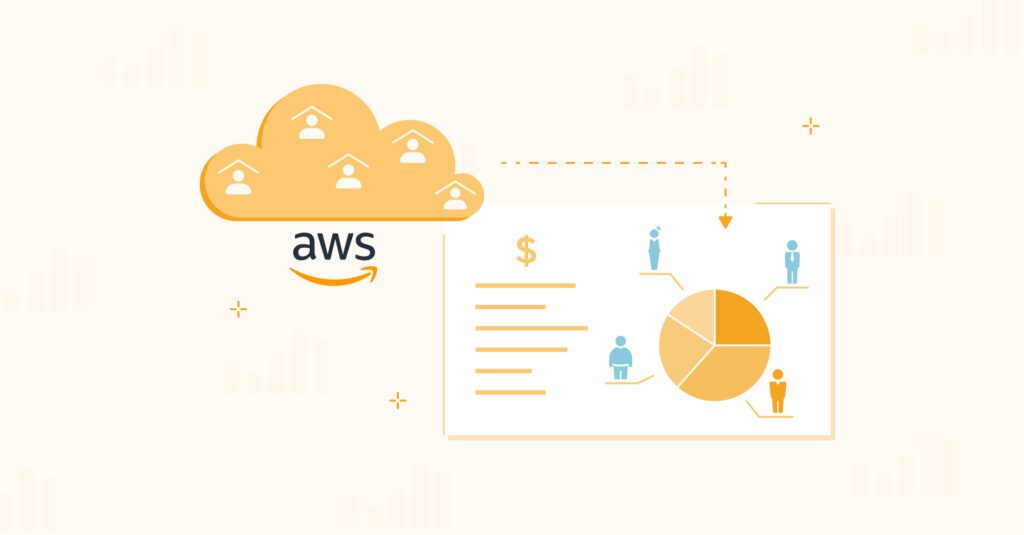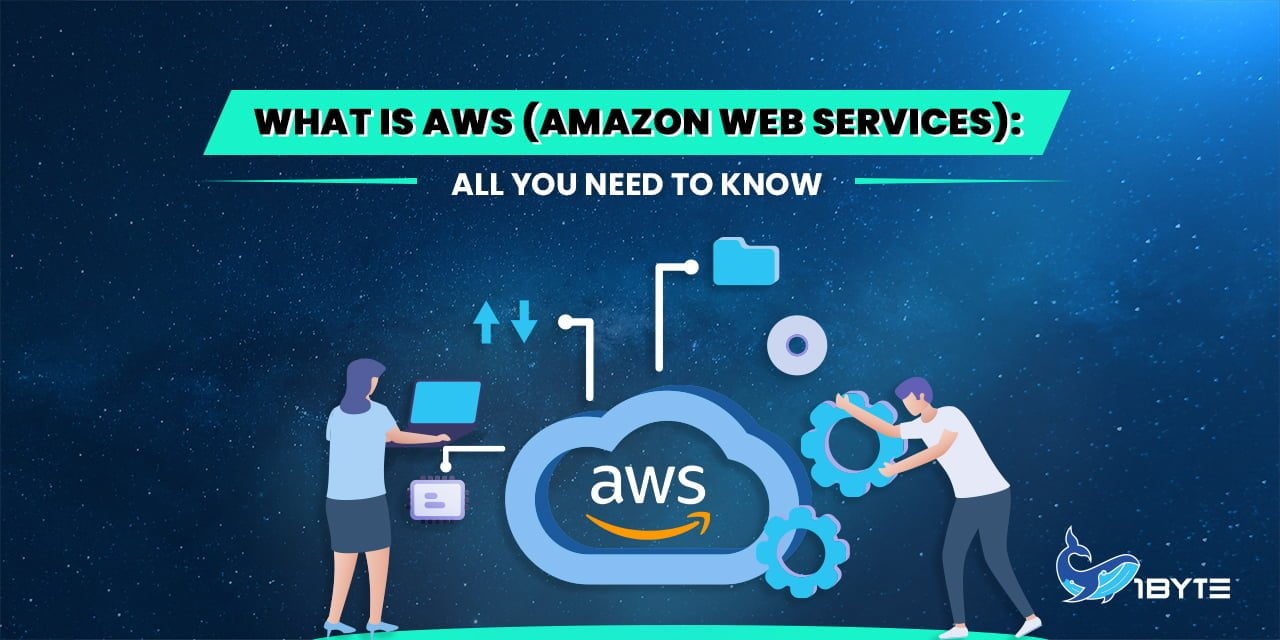The most popular cloud service provider in the industry is Amazon Web Services, which provides over 170 AWS services to developers worldwide so they can use them whenever they need to from any location. This post will dive deep into the definition, pros, and cons, as well as the usage of AWS.

Before studying AWS, let us walk you through the definition of cloud computing first. In short, cloud computing is when you store and access data over the internet. It includes many online services such as servers, databases, and user software. With cloud computing, no hard disk is required, and all the data can be accessed from anywhere in the world.
What Is AWS?
AWS stands for Amazon Web Service, which is a comprehensive and cost-effective cloud computing platform provided by Amazon. It provides a combination of IaaS, PaaS, and SaaS for organizations and enterprises to implement in up to 190 countries worldwide. AWS services can also provide easy-to-use tools such as compute power, database storage, and content delivery services.
History of AWS
In the year 2000, Amazon launched Merchant.com and made it possible for other shops to start their own online shopping sites by giving support and help with their e-commerce engine. Amazon Web Services was made so that software developers could separate their services and move to a single platform. It did, however, have a lot of trouble deploying apps because they couldn’t make these programs any faster. This was because each project needed its own resources and didn’t have any ways to use them again or make them bigger. Also, it takes a lot of time to build the database and storage parts of a single project. They needed a standard set of infrastructure services that could be used as a model for future projects.
Around the year 2000, Amazon was still a small, scrappy eCommerce company that was struggling to grow because of all the technical debt it had built up since it started. Amazon decided that its internal development teams needed to start making modules that could be used more than once. Because of this, those groups were able to make new features faster because they didn’t have to keep re-inventing the same things.

Over time, the number of internal services offered kept growing. As a result, more and more employees within the organization started to think that there might be a chance for new business there. Amazon Web Services was first put on the market in 2004. In 2006, three public pay-as-you-go services were added. At the time, the company was testing the waters of what is now called “cloud computing,” which had not been done before.
AWS was able to get a big head start on competitors like Microsoft Azure and Google Cloud Platform because there wasn’t much competition in the first few years after the company started up in 2006. This gave AWS the chance to build up a large number of customers. Since a long time ago, AWS has been the most successful cloud provider, and it currently has the largest market share.
AWS cloud products were launched in 2006 to handle online retail operations for Amazon.com. AWS was one of the pioneers in inventing a pay-as-you-go cloud computing model that allows users to store and proceed with payments when needed.
Some milestones of this awesome platform are:
- 2002 – Amazon.com launched AWS services
- 2006 – AWS cloud products were introduced to the world
- 2012 – First customer event of AWS
- 2015 – Achieved $4.6 billion in revenue
- 2016 – Revenue exceeded the $10 billion target
- 2016 – Introduced AWS snowball and AWS Snowmobile
- 2019 – Released about 100 cloud services in total
The Reach
AWS has 25 operational regions that are spread out over all six continents. The global infrastructure of the company is made up of these regions. There are a number of different availability zones in each region. These are the actual places where the computers are kept. They are placed in different parts of the world so that a single disaster is less likely to affect an entire region.
Amazon Web Services content delivery network has more than 200 edge locations in different parts of the world (CDN). In addition to the places that anyone can go to, there are a few places that only certain people can go to. People who work for or in the U.S. government have access to two different parts of the AWS GovCloud platform. China also has two areas that are run by local, qualified businesses that follow China’s laws and rules. Amazon Web Services keeps up a private, high-speed fiber-optic network that links all of these availability zones and edge locations in all of its regions.
Top Companies That Use AWS
Numerous businesses use AWS to create, distribute, and host applications, including tech behemoths, startups, governments, food producers, and retail businesses. There are more than one million active AWS users, according to Amazon. Some businesses that utilize AWS are Airbnb, Netflix, Johnson & Johnson, Adobe, Hitachi, etc.
The Competitive Advantages
Amazon Web Services includes more than 200 different computing distribution services, such as API development tools, cloud computing, data analytics, and cloud storage. Because of this, almost every computer science professional is likely to use some part of AWS. Professionally, there are many reasons to learn about Amazon Web Services (AWS), such as data storage, cybersecurity, cloud computing, and advanced development support. No matter what you want to do in computer programming, data science, or cybersecurity, learning AWS will give you access to a set of skills that are in high demand. Because AWS has such a wide range of applications, it is a great choice for anyone who wants to go further in a computer-related career and wants to learn something new.
AWS lets people and smaller businesses who want to use these services pay as they go. This is because it works on a metered, pay-as-you-go model. Due to said reasons, AWS is worthy of learning if you want to become a computer programmer or a data scientist and want to learn important tools that you will likely use often in your work life. By using Amazon Web Services, people can greatly increase the amount of computing power they have access to for building things like apps and databases. Smaller businesses and new companies can use Amazon’s huge server farms to buy access to a level of computing power they would never be able to get to on their own. This gives them a chance to compete with bigger businesses.
In the next section, we will delve more specifically into the kind of benefits AWS offers for each category of their services.
Applications of AWS Services
Website storage and backup and social media applications are some of the most important usages of AWS. The top applications of AWS are listed below:
1. Storage and Backup
Storage ability is the top reason why businesses choose AWS for their website. It provides multiple easy-to-use storage options and allows users to index files and run vital business functions.
2. Websites
Similar to web applications, businesses can host their website on AWS.
3. Gaming
AWS can provide a huge amount of computing power to run gaming applications, which helps users to have a smooth gaming experience.
4. Mobile, Web, and Social Applications
The top feature that makes AWS stand out from cloud services is its ability to operate and scale mobile applications, e-commerce, and SaaS application. API-driven code on AWS allows businesses to build and scale applications without any OS and other systems.
5. Big Data Management and Analytics (Application)
- Elastic Map from Amazon reduced the use of the Hadoop framework to process big volumes of data.
- To examine and analyze the streaming data, use Amazon Kinesis.
- To manage, extract, transform, and load jobs, use AWS Glue.
- With the free utility Elastic-search, Amazon Elastic-search Service enables a team to perform log analysis and tool monitoring.
- Data querying via Amazon Athena.
- To visualize data, use Amazon QuickSight.
6. Artificial Intelligence
- Voice and text chatbot technology is available from Amazon Lex.
- Text-to-speech applications like Alexa Voice Services and Echo devices can be translated using Amazon Polly.
- Utilizing Amazon Rekognition to examine the face and picture
7. Messages and Notifications
- Using Amazon Simple Notification Service (SNS) for core or business communications is beneficial.
- IT specialists and marketers can use Amazon Simple Email Service (SES) to receive or send emails.
- To enable organizations to subscribe to or publish messages to end users, developers can use Amazon Simple Queue Service (SQS).
8. Augmented Reality and Virtual Reality
Amazon Sumerien’s service allows users to apply AR and VR applications to 3D web applications, Marketing, E-commerce, Online education, and so on.
9. Game Development
Gaming companies that offer back-end development services, analytics, and other development tools prefer to use AWS as it provides a comprehensive and strong cloud computing service. It also lets developers store game data and analyze game performance to develop games accordingly.
10. Internet of Things
- In addition to providing a back-end platform for managing IoT devices, the AWS IoT service also allows for data ingestion to database services and AWS storage.
- Limited IoT functionality is provided to hardware by the AWS IoT Button.
- For the installation of IoT devices, AWS Greengrass provides AWS computing.
Advantages and Disadvantages of AWS
| Advantages | Disadvantages |
|
|

The Benefits of Using AWS
Businesses of all sizes use AWS services in some way or another. Intricately says that as of the 6th of July in the year 2020, 1,240,804 people are using Amazon’s products and services. These huge numbers are a direct result of the many benefits that both consumers and businesses get from it.
1. Availability
Amazon Web Services runs its business out of dozens of data centers, also called “availability zones,” that are spread out across the world in 87 different places. An AZ is a building where there is more than one physical data center. A region is a group of AZs that are close to each other and are connected through low-latency network connections.
A company may choose to run its business in one or more AZs for a number of reasons, such as regulatory compliance, being close to its end users, or making the most of its availability. AWS customers can, for example, set up virtual machines (VMs) and copy data to multiple availability zones (AZs) to create a highly reliable cloud infrastructure that can handle the failure of individual servers or an entire data center. “Resilient cloud computing” is the name for this kind of infrastructure.
Amazon Elastic Compute Cloud (EC2) is a service that lets you use virtual servers to do computing. The EC2 instances are the names for these virtual servers. The Amazon Elastic Compute Cloud (EC2) service lets users choose from dozens of different types of instances, each with its own size and capacity. These are made to work with certain kinds of applications and workloads, such as those that need a lot of memory or need to be able to work quickly. AWS also has a service called “Auto Scaling.” With this feature, users can change capacity on the fly while still keeping the health and performance of the instance.
The AWS control plane, which is made up of APIs, and the AWS Management Console are both spread out across the different AWS Regions, providing extra availability. A multi-AZ architecture is also used within each region to allow for resilience and make sure that services are always available. Customers will no longer have to rely on a single data center for mission-critical services. Amazon Web Services can do maintenance on their infrastructure without stopping any of their most important customer services.
2. Security
Some people might say that using Amazon Web Services is a lot safer than having a business run its own website or storage space. Amazon Web Services runs dozens of data centers in different parts of the world. Each of these centers is well taken care of and constantly watched. When the locations of the data centers are spread out, it is less likely that a disaster in one area will cause irreversible data loss for the whole world. Imagine for a moment that the day before a hurricane hit the area, Netflix had all of its backed-up personnel files, content, and data in one place. There would be no order at all.
In reality, it is not a good idea to store your data in a place that is easy to find and where hundreds of people have a good chance of getting in. AWS has done everything it can to keep its data centers secret by putting them in places that are hard to get to and only letting people in who have a business reason to be there.
Because Amazon has a lot of experience with cloud services, outages and possible attacks can be found quickly and fixed easily 24 hours a day. Also, both the data centers and the information they store are protected from unauthorized access. This is not true for a small business where a single IT expert works out of a larger office to handle all of the IT needs of the business.
3. Networking
Networking Services from AWS provide a cloud platform that is both very secure and able to connect a physical network to a private virtual network at a very high rate of data transfer.
Amazon Virtual Private Cloud (VPC) is a networking feature in AWS that gives you a private cloud and security that is built in. This is what Amazon VPC stands for. EC2 comes with VPC at no extra cost.
By using the AWS Direct Connect Service, users can avoid having to connect through the internet. The price is based on the number of hours.
Amazon Route 53 is a web service for dynamic name servers (DNS) that is hosted in the cloud and has high availability and the ability to grow. By doing this, which involves turning the text address into an IP address, it saves money and gets end-users to cloud applications quickly and easily.
4. Scalability
The fact that the cost of using Amazon Web Services is based on how much data customers send makes it a great choice for small and new businesses to use Amazon for their computing needs. AWS is a great place to start a new business from scratch because it gives businesses access to all the tools they need to start doing business in the cloud. Amazon provides cost-effective migration services for businesses that want to move their current infrastructure to AWS. This can be done without any downtime or problems.
AWS provides access to resources that could help a growing business expand. Because the business model allows for flexible use, customers will never have to think about whether or not they need to reevaluate how they use computers. This means that customers don’t have to spend time thinking about this question. In fact, businesses could probably “set and forget” all of their computing needs if they didn’t have to worry about money.
5. Management
Elastic Beanstalk can be used to set up and scale Web applications written in Java,.NET, PHP, Node.js, Python, and Ruby. It’s easy to keep an eye on the health of an app and its log files. CloudFormation makes it easier for businesses and developers to set up important AWS resources with the help of businesses. It helps keep track of all of these resources in one place, so less time is spent on management and more time can be spent making applications. The developers’ interface for managing the cloud infrastructure can be either a text file or a template.
Amazon CloudWatch is another tool for keeping an eye on AWS resources and custom apps that run on the AWS platform. It helps put all operational data into logs and gives access to those logs through a single interface.
6. Migration
Amazon Web Services (AWS) has a number of tools and services that are meant to help users move their applications, databases, servers, and data into AWS’s public cloud. The AWS Migration Hub is a centralized site that helps people move from on-premises environments to the cloud by offering monitoring and management tools. After moving to the cloud, EC2 Simple Systems Manager helps an IT team set up AWS instances and systems that are still on-premises.
Amazon has also teamed up with a number of different technology companies to make it easier to set up hybrid cloud installations. With VMware Cloud on AWS, you can now use the software-defined data center technology that VMware built in the AWS cloud. Red Hat Enterprise Linux for Amazon EC2, the result of another successful collaboration, brings Red Hat’s operating system to the Amazon Web Services cloud.
Once applications, databases, servers, and data have been moved to the cloud or a hybrid environment, tools like AWS Outposts can provide AWS services and infrastructure across different environments.
7. Cost
Jeff Bezos says that Amazon Web Services is like the utility companies that were around in the early 1900s. A company that needed power 100 years ago would build its own power plant. But as soon as factories could buy electricity from a public utility, the need for expensive private electric plants started to go down. AWS is trying to get businesses to move their computing operations to the cloud instead of continuing to use traditional hardware.
In the past, businesses that needed a lot of storage space had to build and run their own storage facilities. If you want to keep your data in the cloud, you may have to sign a pricey contract for a lot of storage space so that your business can “grow into” it. If a company builds or buys too little storage space, it could be disastrous if the business takes off or is very expensive if it doesn’t.

The same is true for the processing power that can be used. In the past, businesses that had a lot of customers at once had to buy a lot of extra power to keep everything running smoothly during peak hours. During slow times, like May for tax accountants, computers sit idle and cost the company money even though they are not being used.
When a business uses AWS, it only pays for the resources it uses. Building a storage system doesn’t cost anything upfront, and you don’t have to guess how much you’ll use. Customers who use Amazon Web Services only use the resources they need, and the costs are automatically adjusted.
8. Storage
Amazon’s Simple Storage Service (S3) offers scalable object storage that can be used to back up, collect, and analyze data. IT experts save their data and files as S3 objects, which can be up to five gigabytes each, and store them in S3 buckets. This keeps their data and files in order. A company can save money and make more money by using Amazon Glacier for long-term cold storage or S3’s Infrequent Access storage class.
Amazon Elastic Block Store can give you block-level storage volumes for storing data that stays around when you use EC2 instances. Amazon Elastic File System is a way to store files in the cloud that Amazon manages.
A company can also move data to the cloud using storage transport devices like AWS Snowball, Snowball Edge, and Snowmobile. It can also use AWS Storage Gateway to give on-premises applications access to cloud data. Businesses can do either of these two things.
9. Analytics
AWS Analytics Services offers solutions for data analytics like Hadoop, orchestration and real-time streaming, and data warehousing. The tool that businesses, data analysts, researchers, and developers use to process chunks of data is called EMR (Elastic MapReduce) and it is an analytics tool. A rate per hour is used to figure out how much it will cost. On top of that, Redshift has different ways to analyze data.
10. Databases
AWS can grow relational and NoSQL databases, as well as offer data warehousing and in-memory caching with capacities in the petabyte range. DynamoDB is the name of the NoSQL database that can store a lot of data at an affordable price. By using EC2 and EBS, users can work on their own databases within AWS. Relational Database Service (RDS) and Amazon Redshift are the two database services that AWS offers.
Amazon RDS is used on AWS so that MySQL, Oracle, SQLServer, or PostgreSQL servers can be managed and their businesses can grow. When setting prices for RDS, both the total amount of storage and the number of instances hours are taken into account. Redshift is a service for storing data. Users of this service can choose to store their data in columns instead of rows. The price is based on the number of instances hours. For example, each hour costs $0.
The 7 Main AWS Services
What is AWS used for? For cloud applications, Amazon offers a wide range of services. Here are the top AWS ecosystem services, along with a quick explanation of how developers use them.
1. Compute Service
This service aims to assist developers in building, testing, and deploying applications within the cloud platform.
AWS EC2: This service lets users find and rent virtual machines and scale when required.
Developers can choose from various instance types, allowing them to choose the CPU, memory, storage, and networking capabilities necessary for their applications.
AWS Lambda: Among the serverless computing, the option is AWS Lambda. It is also in charge of running application code.
It enables you to run an application without having to deal with managing servers.
2. Storage
To archive data, WS offers a web data storage service. Additionally, disaster data recovery with excellent durability is a major benefit.
Amazon S3: Amazon S3 is an open cloud-based storage service created for online data storage.
It also provides storage on a web-based services interface and focuses on simple developers’ computing tasks.
Amazon EBS: Amazon offers a huge storage capacity for persistent data. EBS is usually used for primary data storage such as database, block-level, and file storage.
3. Database
AWS database service allows business users a secure, scalable, and cost-saving database instance in the cloud.
DynamoDB: offers quick and effective performance, and it causes no issues with scalability.
Its instant built-in security, backup, and restore features can be accessed from anywhere.
RDS: It is a managed distributed relational database cloud service that aids programmers in easily managing and scalability a database.
We created it to make it easier for developers to access relational databases when setting it up, running it, and scaling it.
4. Networking and Delivery of Content
AWS’s highly secure cloud infrastructure keeps your business data safe and connects your physical network with your private VN at a high-speed transfer.
VPC
- It allows you to upload AWS resources to a private virtual cloud.
- With AWS, you can control your cloud network environment completely, including your IP address range, root table configuration, network gateway, and subnets.
- You can use both IPv4 and IPv6 simultaneously for your website in a highly secure environment.
Route 53
- This web service, which has a highly available DNS, allows you to route software by converting a text into an IP address.
- Developers use it as a cost-saving option to route end users to cloud applications.
5. Developer Tools
Application source code can be deployed and run automatically by AWS. The server and instances are also uploaded to the workload.
CodeStar is a service that allows users to manage application development in a single place. With the assistance of this service, developers can easily build and deploy applications on AWS.
Code Build: As a result, controlling physical servers is no longer a chore, and continuous scaling makes it easier for developers to write and test code.
Simply put, it compiles your code, runs unit tests, and produces deployable output artifacts.
6. Security, Identity & Compliance
By granting a limited amount of access to a select group of users, it aids in maintaining a secure environment for your AWS resources.
IAM: IAM stands for Identity Access Management and is a framework that aids in maintaining access to AWS services in a secure way. The service grants you Secure access to AWS services powered by the AWS EC2 application and shared access to your AWS account.
KMS: It allows users to generate and control the encryption keys that are employed to encrypt data. The service offers a key generation technique that simplifies using digital signatures in your apps.
7. Management Tools
Businesses can minimize costs, reduce risks, and automate all the resources that run efficiently on the AWS infrastructure.
Cloud Watch: It is a monitoring tool for both customer applications and AWS platform resources. Thanks to the service, you may access all of your operational data in the form of logs from a single interface.
Cloud Formation: Using this service, you can monitor all of your AWS resources in one location, allowing you to spend more time developing apps and administering them less. Developers can use a text file or a template to control their cloud architecture.
A Breakdown of AWS Prospects
In order to learn and understand what AWS is, you have to get down to things like career prospects, pricing models, and more. This section will be dedicated specifically to the purpose of presenting AWS in the clearest way possible.
AWS Pricing
Amazon Web Services charges for its cloud services on a “pay-as-you-go” basis. This means that you pay either by the hour or by the second. Customers who pay ahead of time or agree to use the service for one or three years can get a discount that lets them reserve a certain amount of computing power at a lower cost. Customers are the only ones who can choose this option. Customers can get discounts based on how much of a certain service they use. This means that each gigabyte of storage space they buy will be cheaper the more of that service they use.
There is also the AWS Free Tier, which is another option. Customers can use up to 60 products at no extra cost and can start working on the AWS platform right away. For the Free Tier plan, there are three different options: always free, free for 12 months, and trials.
Potential clients can use AWS’s pricing calculator to estimate expenditures. AWS-certified specialists from third-party companies are also available to help customers choose the right pricing plan.
AWS Learning
Amazon offers a wide range of training opportunities, such as courses and events, with the goal of helping employees build and test their skills so they can use the cloud to its fullest extent. Because AWS is always changing, these courses are always being updated to make sure that customers have access to the most up-to-date cloud-based knowledge.
Depending on the user’s choice of services for things like the Internet of Things (IoT) and big data, there are both digital and traditional classroom-style ways to learn. Classroom training will be taught by AWS experts who will share best practices. Virtual training, on the other hand, will let you learn from anywhere, at your own pace, and in the comfort of your own home.
People who are AWS Partners can use the Amazon Partner Network (APN). The Amazon Partner Network (APN) is a global platform where AWS technical and consulting experts can work together to build customer solutions. The APN gives businesses access to specialized tools and helps to help them grow their AWS offerings and market and sell those products. Partners can improve both their knowledge and their skills by taking part in training courses. Partners can get AWS certification as a cloud practitioners, architects, developers, or operations professionals by taking part in these courses.
In the area of enterprise training, Amazon Web Services (AWS) offers courses that help businesses reach their business goals by making sure everyone in their organizations knows how to use the cloud. These learning tools can help businesses build a culture of innovation and bring their processes into the 21st century.
AWS Careers
Amazon Web Services is used by a wide range of businesses and jobs. People who have been trained in AWS have a lot of job opportunities because AWS works with a wide range of companies, from NASA to Bloomberg. As of 2022, Amazon Web Services had about 33% of the global market share, making it the most popular distributed cloud computing platform in the world.
Customers of AWS have access to hundreds of different tools, which means it covers a wide range of job titles and subfields in the IT world. No matter where your career goes, learning Amazon Web Services will help you. This is especially true if you work in computer science, data analysis, or information technology.
Cybersecurity Engineer
Since Amazon Web Services is used by hundreds of companies of all sizes, from small startups to large multinational corporations, the data and information that is stored in the cloud must be well protected. Cybersecurity engineers are in charge of making sure that computer networks are both safe and able to work.
These computer science experts will be in charge of building system infrastructure, testing their systems to see how stable they are, and staying up-to-date on security threats. Cybersecurity Engineers are in high demand, especially for systems that run on Amazon Web Services (AWS) platforms. This is because businesses and organizations in this category tend to collect and store a lot of sensitive information.
Data Analyst
Companies that use AWS are hiring a lot of data scientists and analysts to collect, manage, and make sense of the huge amounts of data they are making. A lot of data analysts will work for businesses in the hopes of tracking customer behavior, predicting market trends, or figuring out how to take advantage of market failures.
Because the financial industry needs this kind of analysis a lot, professionals can find well-paying jobs in a number of the biggest cities in the United States. Other types of businesses, like those in professional sports, the entertainment industry, the public sector, and advocacy groups, are moving toward more data-driven models to improve employee productivity.
Machine Learning Specialist

The field of machine learning is just starting to become a viable career choice, and it is becoming more and more linked to AWS. It is getting harder and harder for people to analyze the ever-growing amounts of data that are being collected every day at a speed that is considered to be reasonable. Because of this, more and more businesses are turning to algorithms for machine learning to automate the process of learning from each person’s actions and turning that information into recommendations that can be used. This could be for something as small as recommendation algorithms on streaming services, or it could be for something as big as automating trading decisions on the stock market that move millions of dollars without human oversight. As time goes on, there will be more need for these experts because machine learning technology is getting better. This is in part because of the tools available through AWS.
AWS Future
In 2021, Amazon Web Services updated its data analytics services, updated the hardware specs for its virtual machines, and entered the business robotics industry for the first time. In addition to this, it increased the overall operating speed and launched a 5G service at the same time.
Also, it’s likely that AWS will keep putting money into AI as a way to help applications and workflows, give customers more personalized services, increase customer engagement, and even find cases of fraud. Amazon Rekognition, Amazon Lookout for Vision, AWS Panorama, Amazon Textract, Amazon Lex, and Amazon Personalize are all examples of similar products that are now for sale or have been announced as being in development.
There is a good chance that Amazon will use the tools offered by AWS to help it grow its line of Internet of Things (IoT) products. When Amazon announced ExpressLink in June 2022, it gave hints about the company’s bigger plans. ExpressLink is a service that helps Internet of Things modules connect to the cloud more quickly and easily.
In the not-too-distant future, it is expected that Amazon Web Services will make more money. By next year, Amazon Web Services sales should be close to $101 billion, which would be a huge achievement for the company. This is because the company thinks its income will double from $35 billion in 2019 to $62 billion in 2021. But if the government pays more attention to antitrust issues in the cloud computing business, Amazon Web Services might not be able to break any records.
FAQs
What does AWS stand for?
AWS stands for Amazon Web Services. It is a cloud computing platform that offers a broad set of global computing, storage, database, analytics, application, and deployment services that help organizations move faster, lower IT costs, and scale applications.
Conclusion
In this introductory tutorial on “what is AWS,” we covered the definition of cloud computing, the background of AWS, and a thorough overview of all of its services.
AWS’s cloud computing services are used by a wide range of people in today’s fast-paced and competitive world, including executives, computer scientists, app designers, corporations, and industrialists. The AWS Cloud is able to offer facilities that are not only high quality and reliable but also affordable and scalable because it evaluates its cloud to meet the pricing needs of its customers. This means that it can work with businesses of all sizes, from the newest start-up to a Fortune 500 company.
If you have more questions, please don’t be afraid to get in touch with us! 1Byte can give you enough answers to all of your cloud-related questions and help you along the way because we are an official AWS Partner as well as a cloud service provider ourselves and have a staff in which we have full faith and trust.

